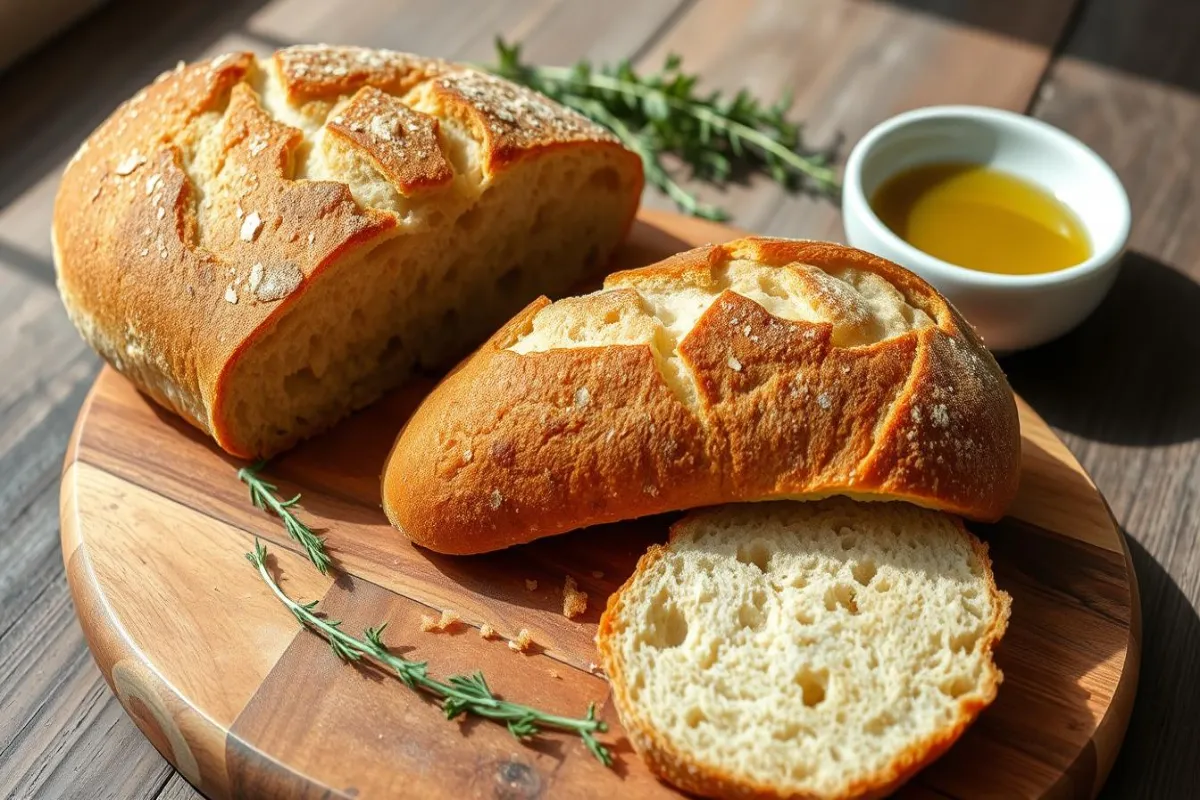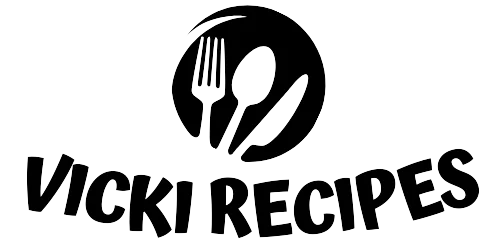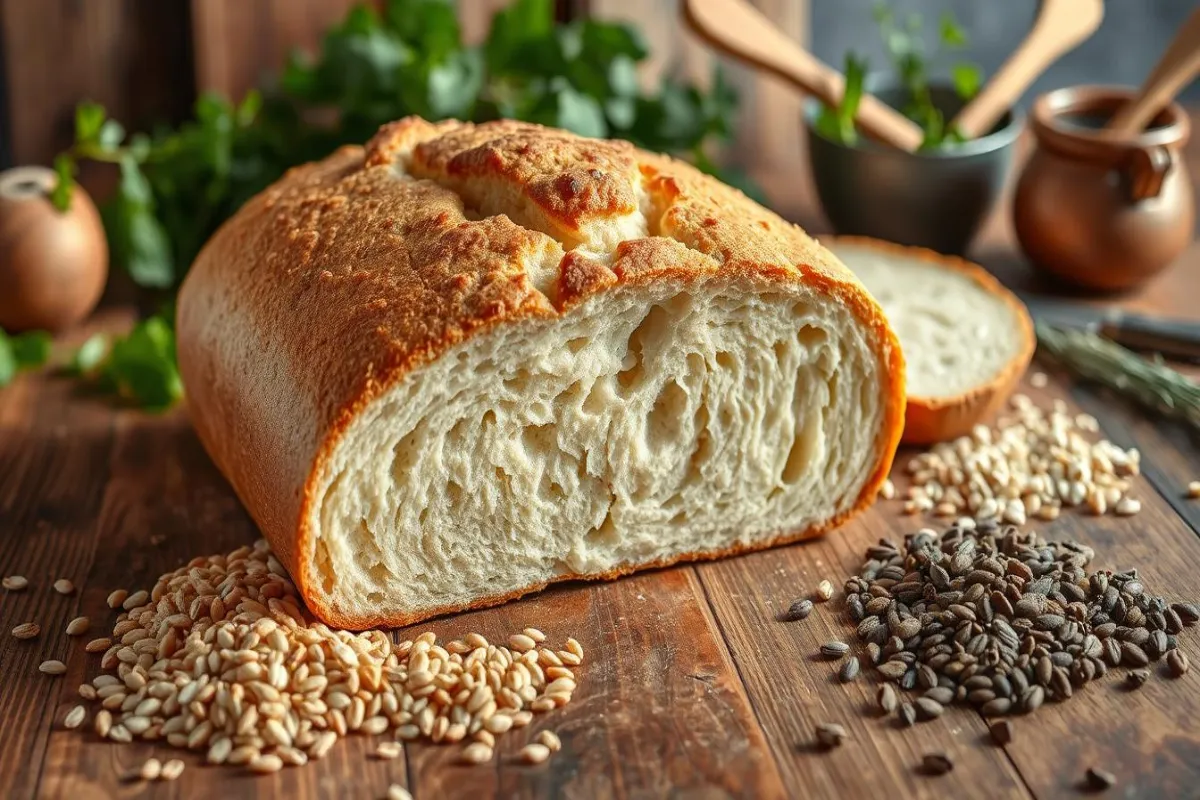Living gluten-free can be tough, especially when it comes to finding good gluten-free bread. If you have celiac disease, a wheat allergy, or simply want to avoid gluten, there’s great news: a variety of delicious and simple bread options are available. From traditional yeast-based recipes to grain-free and vegan alternatives, you can enjoy satisfying baked goods without compromising your dietary needs. In this guide, we’ll explore different types of celiac safe bread choices, providing you with the knowledge to make healthy, tasty, and fulfilling celiac safe baked goods at home.
Understanding gluten and the benefits of a celiac safe diet is key. We’ll also explore alternative flours and the art of celiac safe bread baking. This article will help you enjoy a celiac safe lifestyle without giving up on your favorite breads.
Whether you’re craving a crusty loaf, soft sandwich bread, or a versatile substitute, we’ve got you covered. Let’s explore the tasty and easy no gluten bread options together. By the end, you’ll be making delicious and healthy no gluten baked goods that will please your taste buds and support your health.
Understanding Gluten Free Bread
More and more people are choosing a celiac safe lifestyle. This is because gluten, found in wheat, rye, and barley, can cause problems for some. Knowing about gluten and the benefits of a gluten-free diet helps you pick better bread and care for your health.
What is Gluten and Why Go Gluten-Free?
Gluten is a protein in many grains that makes them elastic. But for those with celiac disease or gluten intolerance, it can cause harm. By avoiding gluten, you can avoid these issues and find new flours for baking.
Benefits of Embracing a Gluten-Free Lifestyle
Choosing a no gluten life can bring many benefits, including:
- Improved digestive health by reducing inflammation and discomfort
- Increased energy levels as the body no longer has to cope with the effects of gluten
- Reduced risk of chronic diseases, such as type 2 diabetes and certain autoimmune conditions
- Clearer skin and reduced skin irritations
“Going gluten-free has been a game-changer for my health. I no longer experience the bloating and digestive issues that used to plague me, and I feel so much more energized throughout the day.”
Understanding gluten and the benefits of a no gluten diet helps you make better choices. This includes what bread you eat and how it affects your health.

Exploring Alternative Flours for Gluten Free Bread
Exploring grain-free baking means trying different flours. There’s more than just wheat flour out there. These alternative flours are great for those on a paleo diet or looking for healthy baking options.
Almond flour is a favorite. It’s sweet and moist. Made from almonds, it’s free of gluten and packed with healthy fats, fiber, and protein. It’s perfect for paleo-friendly and grain-free baking.
Coconut flour is also popular. It’s made from dried coconut and is low in carbs but high in fiber. It adds a coconut taste to baked goods. You can use it alone or mix it with other flours for no gluten bread.
Gluten-free all-purpose flour blends are a convenient choice. They mix different flours like rice, tapioca, and potato starch. They’re like traditional wheat flour but gluten-free. They make healthy baking easier.
| Alternative Flour | Key Properties | Best Uses |
|---|---|---|
| Almond Flour | Naturally sweet, moist texture | Paleo-friendly, grain-free baking |
| Coconut Flour | Low in carbs, high in fiber, subtle coconut flavor | Paleo-friendly, grain-free baking |
| Gluten-Free All-Purpose Flour Blends | Mimics properties of wheat flour, convenient | Healthy baking, simplifying gluten-free bread-making |

Trying these alternative flours opens up new possibilities for gluten-free bread. They’re great for those on a paleo diet or just looking to try new things. These flours let you make grain-free bread that’s both tasty and healthy.
Mastering Gluten Free Bread Baking
Baking gluten-free bread is a unique and rewarding journey. It’s perfect for those who follow a gluten-free diet or just love trying new recipes. I’ll show you the key ingredients and tools you need. Plus, I’ll share tips for solving common baking problems.
Essential Ingredients and Equipment
To make great gluten-free bread, you’ll need a few important things. Start with a top-notch gluten-free flour blend. This mix usually includes flours like rice, tapioca, or almond. Xanthan gum is also crucial, as it helps the dough stick together and gives it the right texture. And, of course, you’ll need active dry yeast for that perfect rise and taste.
For kneading, a strong stand mixer is a big help. You’ll also need a loaf pan, parchment paper, and an oven thermometer to get your temperature just right. With the right tools and ingredients, you’re ready to master gluten-free bread baking.
Troubleshooting Common Baking Challenges
Gluten-free baking comes with its own set of challenges. But, with a little troubleshooting, you can solve them. If your bread isn’t rising, check your yeast or oven temperature. Finding the perfect texture can be tricky, but trying different flours and adjusting xanthan gum can help.
Don’t get discouraged by baking failures. They’re just part of the learning process. Stay patient, tweak your recipes, and enjoy the journey of improving your gluten-free bread baking skills.
“Baking gluten-free bread may require a bit more effort, but the reward of a perfectly risen, delicious loaf is well worth it.”
Healthy and Delicious Gluten Free Bread Recipes
Are you looking for tasty and healthy no gluten bread options? You’re in the right place! I’ll share a variety of delicious recipes. They cater to different tastes, including vegan and grain-free choices. From fluffy sandwich loaves to savory biscuits, these gluten-free breads will make your taste buds happy and your body healthy.
Vegan and Grain-Free Bread Options
Gluten-free living doesn’t mean you have to give up on flavor or texture. Check out our vegan and grain-free bread recipes. They are both healthy and delicious:
- Almond Flour Sandwich Bread: A nutty, protein-rich loaf perfect for sandwiches, toast, or as a versatile side.
- Cashew Flour Biscuits: Buttery, flaky biscuits made with creamy cashew flour for a tender, grain-free delight.
- Coconut Flour Dinner Rolls: Soft, subtly sweet rolls that pair beautifully with soups, stews, or as a simple accompaniment to any meal.
- Quinoa Flour Focaccia: A savory, chewy focaccia bread made with the ancient grain of quinoa for a nutritious twist.
These gluten-free, vegan bread and grain-free baking options offer healthy, gluten free bread recipes. They satisfy your cravings without sacrificing flavor or nutritional value. Try these healthy gluten-free options to find your new favorite breads.
“Baking gluten-free bread has never been easier or more delicious. These recipes prove that you can enjoy the comforts of bread without the gluten.”
Gluten Free Bread for Special Diets
For those with celiac disease or wheat allergies, finding gluten-free bread is crucial. We’ll look at what’s needed for these diets. This way, you can enjoy tasty and safe gluten-free bread.
Accommodating Celiac Disease and Wheat Allergies
Celiac disease makes the body react to gluten, harming the small intestine. People with this must avoid gluten in wheat, barley, and rye. Wheat allergies also cause an immune reaction to wheat proteins.
For gluten-free baking, use top-quality, gluten-free ingredients. This means alternative flours like rice, almond, or cassava. Also, use xanthan gum or psyllium husk as binders. Always check labels and choose gluten-free certified brands for safe bread.
It’s also key to prepare and handle food safely to avoid gluten. Use dedicated gluten-free baking tools to prevent cross-contamination. By doing this, you can make healthy gluten-free options for those with celiac disease or wheat allergies.
Artisan Gluten Free Bread
Gluten-free baking doesn’t mean you have to give up on artisanal bread. We’ll explore artisan gluten-free bread, showing you how to make beautiful, rustic loaves. These loaves will have a unique flavor and texture.
Artisan gluten-free bread baking is about understanding alternative flours and fermentation. By choosing high-quality ingredients and using traditional methods, you can make artisan gluten-free bread as good as wheat-based bread.
Using sourdough starter is key for an artisanal texture and flavor in gluten-free bread. It adds depth and complexity to the bread’s taste. It also makes the bread tender and chewy with a crisp crust. With patience and practice, you can make your own sourdough starter for your artisan bread recipes.
Choosing the right alternative flours is also crucial. Flours like almond, coconut, and cassava add structure, moisture, and nutrition to your loaves. Try different flour blends and ratios to find the perfect taste and texture in your artisan gluten-free bread.
Whether you want a rustic boule, a crusty baguette, or a tender sandwich loaf, artisan gluten-free bread offers endless possibilities. By mastering the art and science of gluten-free bread making, you can enjoy freshly baked, high-quality bread again.
Let’s explore the secrets to making your own artisan gluten-free bread masterpieces. With creativity and passion, you can take your gluten-free baking to new heights.
Gluten Free Bread: Tasty & Easy Options
If you’re looking to explore the world of gluten free bread, you’re in for a treat! There are many delicious and easy gluten-free bread recipes to try. I’ll show you some tasty options for all skill levels and busy schedules.
Quick breads are a great start. They’re easy to make and don’t need yeast. Try a moist gluten-free banana bread or a savory gluten-free zucchini bread. These quick breads are perfect for busy days or unexpected guests.
If you have more time, try yeast-based gluten-free bread. Make a gluten-free sandwich bread for toast or sandwiches. Or, create a gluten-free focaccia with your favorite toppings. With practice, you’ll get the perfect gluten-free bread.
“Baking gluten-free bread at home can be a game-changer. It allows you to control the ingredients and create something truly tailored to your dietary needs.”
No matter your skill or schedule, there’s a gluten free bread for you. Experiment and find your new favorite recipes. This way, you’ll satisfy your cravings and appreciate gluten-free baking more.
Storing and Freezing Gluten Free Bread
Keeping gluten-free bread fresh and tasty is key. Whether you baked it or bought it, right gluten free bread storage and freezing can help a lot.
Extending Freshness and Preserving Quality
To keep your gluten-free bread fresh, follow these tips:
- Store bread at room temperature in a bread box or paper bag. Avoid airtight containers to prevent moisture buildup.
- Slice only what you’ll eat right away. Sliced bread dries out quicker than whole loaves.
- Wrap leftover slices tightly in plastic wrap or a resealable bag to preserve gluten-free bread quality.
- For longer storage, gluten-free bread freezing is great. Wrap the whole loaf or slices in foil or airtight bags to avoid freezer burn.
With these simple tips, you can enjoy your gluten-free bread for days or even weeks.
Gluten Free Bread Substitutes
Homemade gluten-free bread is great, but sometimes you need something quick. Luckily, there are many gluten-free bread alternatives available. These can be a tasty choice when you’re in a hurry or missing ingredients.
Pre-sliced sandwich bread is a popular gluten-free bread substitute. It’s made from gluten-free flours like rice, sorghum, or tapioca. You can find it in the special diet section of most grocery stores. It’s ready to use, saving you time and effort.
Gluten-free buns or rolls are also great. They’re perfect for burgers, sandwiches, or as a side. Many bakeries and brands offer a range of gluten-free bread alternatives. You can find everything from classic sandwich rolls to soft dinner buns.
For a quick toast or breadcrumb fix, try gluten-free crackers or bread crumbs. These are great for adding texture and crunch to your meals.
| Gluten-Free Bread Substitute | Description | Best Uses |
|---|---|---|
| Pre-Sliced Sandwich Bread | Made with a blend of gluten-free flours, these loaves are ready-to-use and convenient. | Sandwiches, toast, French toast |
| Gluten-Free Buns and Rolls | Variety of options, from traditional sandwich rolls to fluffy dinner buns. | Burgers, sandwiches, side dishes |
| Gluten-Free Crackers and Breadcrumbs | Crunchy alternatives for toast, breading, and more. | Toppings, coatings, breadcrumb substitutes |
Using gluten-free bread substitutes makes enjoying your favorite foods easy. They’re perfect for when you’re short on time or just want something convenient. These versatile options make following a gluten-free diet simple.
Embracing a Gluten-Free Lifestyle
Starting a gluten-free lifestyle can change your life, but it comes with its own set of challenges. In this final section, I’ll share tips and strategies for a smooth transition to a gluten-free diet. You’ll learn about meal planning, dining out, and keeping your diet balanced and nutritious.
Tips for Transitioning to a Gluten-Free Diet
Learning about gluten sources and gluten-free alternatives is key to a gluten-free lifestyle. This knowledge helps you make smart choices when shopping, eating out, and cooking at home. Start by slowly adding gluten-free options to your diet. This approach helps you stay balanced and satisfied.
Meal planning is vital when you’re on a gluten-free diet. Plan your meals and stock up on gluten-free ingredients. This way, you’re ready for any dining out or social event. Try new recipes and explore gluten-free cuisine. There are many tasty and healthy options out there.
Lastly, be patient and kind to yourself as you adapt to a gluten-free lifestyle. It might take some time and effort, but with a positive attitude, you’ll find the benefits. Enjoy nourishing your body and exploring new foods that fit your dietary needs.
FAQ
What is gluten and why do some people need to avoid it?
Gluten is a protein in wheat, barley, and rye. Some people, like those with celiac disease or gluten intolerance, must avoid it. This is because gluten can cause digestive issues, inflammation, and other health problems in their bodies.
What are the benefits of embracing a gluten-free lifestyle?
A gluten-free lifestyle can improve digestion and reduce inflammation. It can also boost energy levels and overall health. It helps manage symptoms of celiac disease and gluten intolerance too.
What are some popular alternatives to wheat flour for gluten-free baking?
For gluten-free baking, you can use almond flour, coconut flour, or gluten-free all-purpose blends. These flours are great for making delicious and nutritious gluten-free bread.
What are the essential ingredients and equipment needed for successful gluten-free bread baking?
For gluten-free bread baking, you need gluten-free flours, xanthan gum, and yeast. You’ll also need a stand mixer, bread pans, and a kitchen scale for accurate measurements.
What are some healthy and delicious gluten-free bread recipes to try?
There are many gluten-free bread recipes to try, including vegan and grain-free options. You can make homemade gluten-free sandwich bread, savory herb loaves, or sweet cinnamon-raisin bread.
How can I accommodate celiac disease or wheat allergies when baking gluten-free bread?
When baking for celiac disease or wheat allergies, choose ingredients and recipes carefully. Make sure to avoid cross-contamination and use certified gluten-free ingredients.
How can I achieve an artisanal quality with my gluten-free bread?
You can still achieve artisanal quality with gluten-free bread. Use long fermentation, shaping, and scoring techniques. This will help create beautiful, rustic gluten-free loaves with a unique flavor and texture.
What are some easy and tasty no gluten bread options I can make at home?
You can make many delicious celiac safe breads at home, from quick breads to yeast-based loaves. Try classic sandwich bread, savory herb loaves, or sweet cinnamon-raisin bread.
How can I properly store and freeze my homemade no gluten bread?
To keep no gluten bread fresh, use proper storage and freezing techniques. This will help extend the shelf life of your homemade loaves and keep them fresh for longer.
What are some store-bought celiac safe bread substitutes I can use?
Sometimes, you might need a quick no gluten bread substitute. There are many store-bought options available. They can be a convenient choice when you’re short on time or ingredients.
How can I successfully transition to a gluten-free lifestyle?
Transitioning to a gluten-free lifestyle can be a big change. But with meal planning, dining out tips, and a balanced diet, you can make the transition smoothly.

